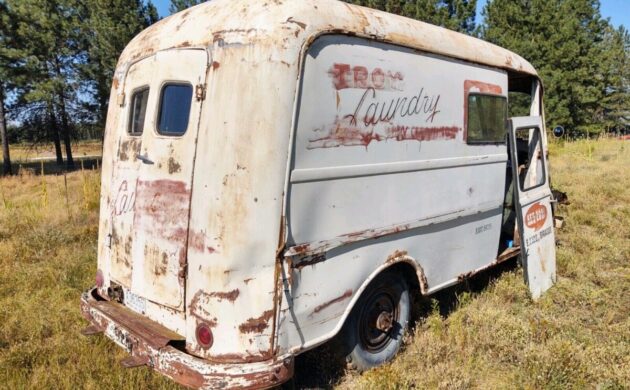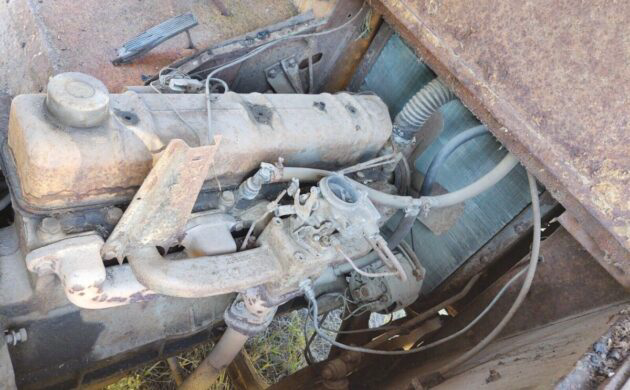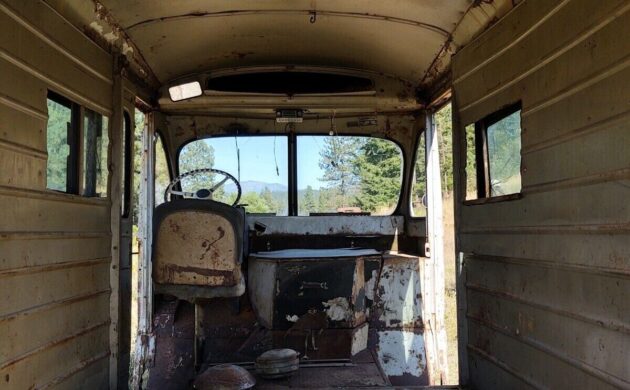Step vans originated in the 1930s as a convenience for multi-stop delivery drivers. Ideal for bread, milk, and anything that was delivered frequently on a specific route, these were designed so the driver could easily step in and out of the cab. As far as vintage step vans go, collectors can choose from a wealth of makers: Divco, Citroen, White, Bedford, Boyertown, and International Harvester, among others. Here on eBay is a 1964 International Harvester Metro step van, for sale at $2,000. The truck is located in Bend, Oregon. The seller is cagey about details, saying “the vehicle is parked at a spot where it was to be renovated.” Further, for removal, “I will help coordinate with the site owner where the car is currently situated” which tells me that the vehicle is not on the seller’s property. Photos show it in a field. He claims to have been ready to spend “upwards of $50k to renovate it myself.” Given the tenor of the ad, I am going to take a wild guess and say it doesn’t run. Better hope the “site owner” is friendly.
The Metro was conceived by International Harvester in 1938 and originally designed by Raymond Loewy during the streamliner years when rounded curves were appearing on locomotives, cars, architecture, and even toasters. The bodies were made under contract by Metropolitan Body Company, in business since 1908. It specialized in truck and van bodies for multiple chassis and is considered the originator of the step van, holding multiple patents for its designs. In 1948, IH purchased Metropolitan outright. The Metro was finally updated in 1964 when its rounded corners were slightly squared and it was given an opening hood. The rear doors were a narrow, barn door type.
The engine supplied was an in-line six-cylinder from IH’s light-duty truck line, along with a manual transmission. Each time the truck line was updated, the vans were given the truck’s new engines and frames. Metros came in many gross vehicle weight capacities and box lengths; you could even buy a dually if you were running a heavy refrigerated truck.
The interior was made for work, not pleasure. The tall seating arrangement made it easy to hop in and out with each delivery, and there’s virtually no accommodation for passengers. Despite the configuration of the van, customization is certainly possible. The band Aerosmith apparently used a 1964 Metro van to conduct its first tours. This one certainly isn’t the celebrity van and will need considerable work both to transport it and resurrect it. Given that, is the price right?






Aerosmith reference,,,nice. That whole episode with American Pickers was pretty hoaky, but sucked in the viewers. Aerosmith was HUGE. I’m sure AP paid the band members( all still alive, amazingly) plenty,although, I heard, a time they’d like to forget.
This? Well, if you’ve priced these outside sheds, that people are living in as a cheap “tiny house”,, many 5 figures, at $2grand, makes this a freakin’ bargain. The only remote chance for this, is a vintage “Sprinter” type camper and that market is pretty exclusive. People that want a Sprinter, just go buy one, not build one. Not much interest,but in it’s day, laundry services were very popular, and this truck hauled a lot of laundry,probably diapers. Disposable ones were a ways off and everybody used cloth diapers. With over 20 million babies in 1964, that’s a lot of,,,um, laundry. Storage shed,,,sorry.
“As is-Where is” = “No way-Jose”
Scrap metal
These truck were everywhere when I was a kid.
I’m dating myself, I know. But at my age, who else would date me?
Scrap metal is an apt description for this scrap heap.
I restored one of these, in this condition, about 9 years ago. It sold quickly after it was restored. I had potential buyers everywhere–musicians, lunch truck owners in California (I’m in Texas), caterers, etc. Made money on the restoration, too. This one is well worth restoring.
The Metro was the vehicle used for hauling us around on the flight line from plane to plane or towing ground support equipment at Wright Patterson, and when I was overseas in SEA with the USAF.
They were parked by the hangars, but never for long, as they were always working as apart of aircraft maintenance.
The Metro was the vehicle used for hauling us around on the flight line from plane to plane or towing ground support equipment at Wright Patterson, and when I was overseas in SEA with the USAF.
They were parked by the hangars, but never for long, as they were always working as apart of aircraft maintenance.
I’d haul it off if he paid me $2000 lol
Huge laugh to see the signage. Drove a red one like this to deliver laundry when I was a teenager. Did not enjoy it as much as the 356 Porsche I bought a few years later.
There is one of these in our little town used formerly as ‘bookmobile’ that anyone could have for the asking. Fix it for what reason?
Where is this bookmobile you speak of located? I’m interested if open to selling. Thanks!
These are very sought after as very few remain. They were all worked to death and then left to rot. This one looks pretty complete compared to most that are left.
lol.. I am the “site owner”! Thanks for the article.. Didn’t mean to be “cagey”, I just don’t know much about the vehicle :).. message me on Ebay if you want to connect to learn more
I want to see a picture of the front end please
Is this still for sale